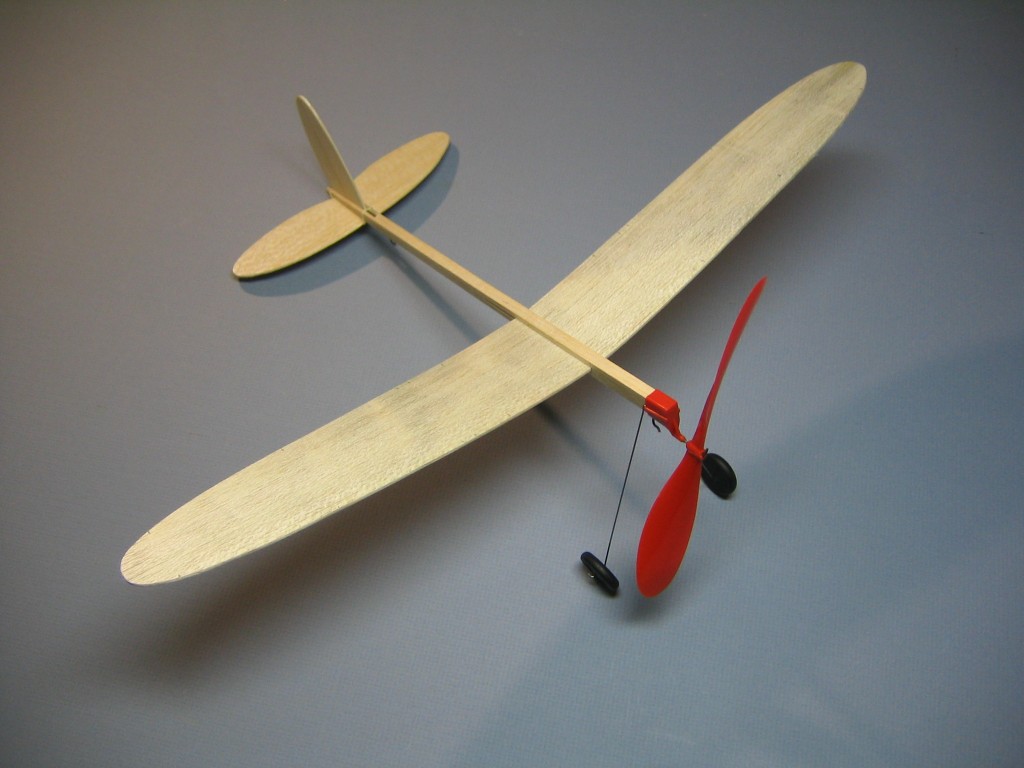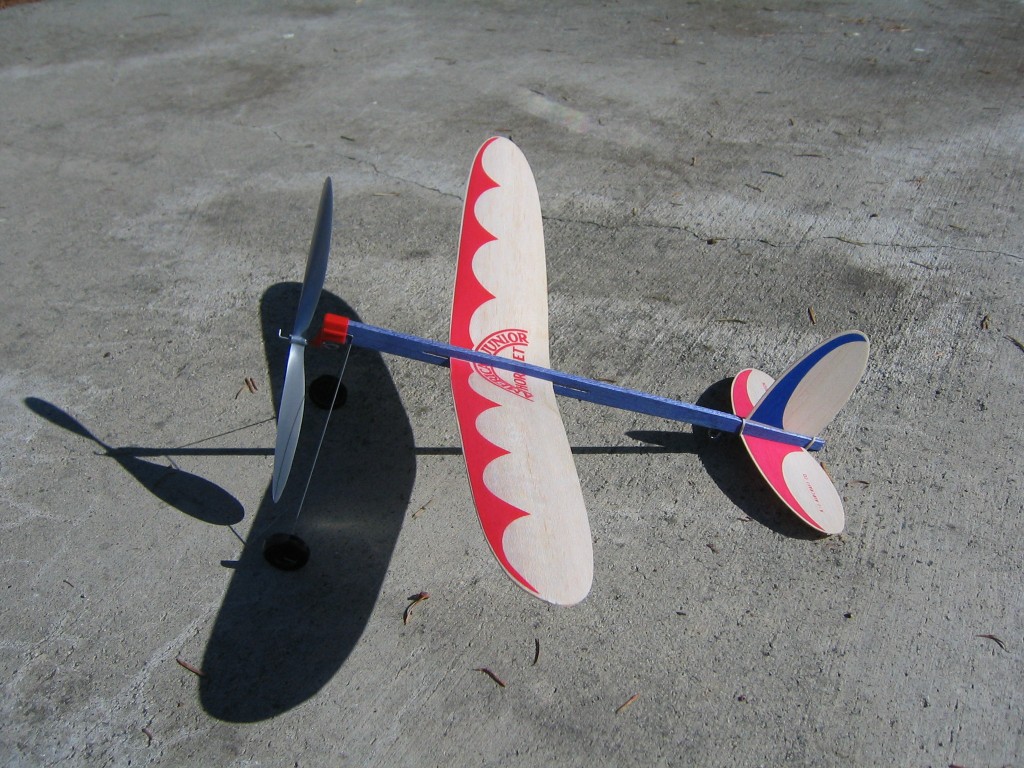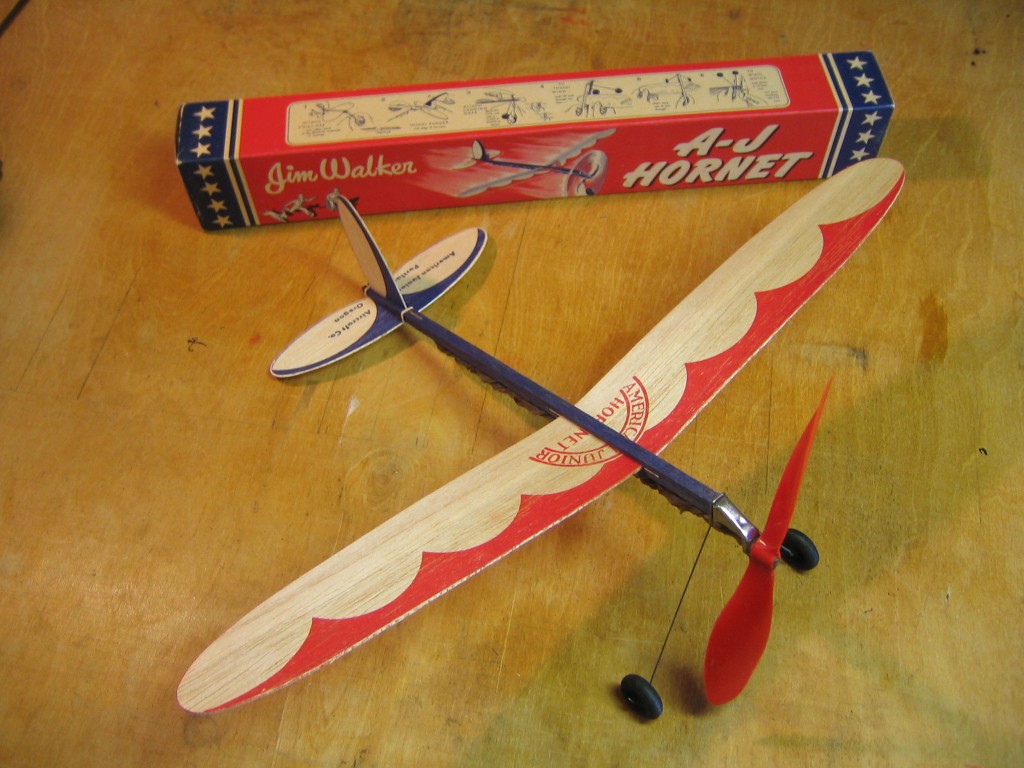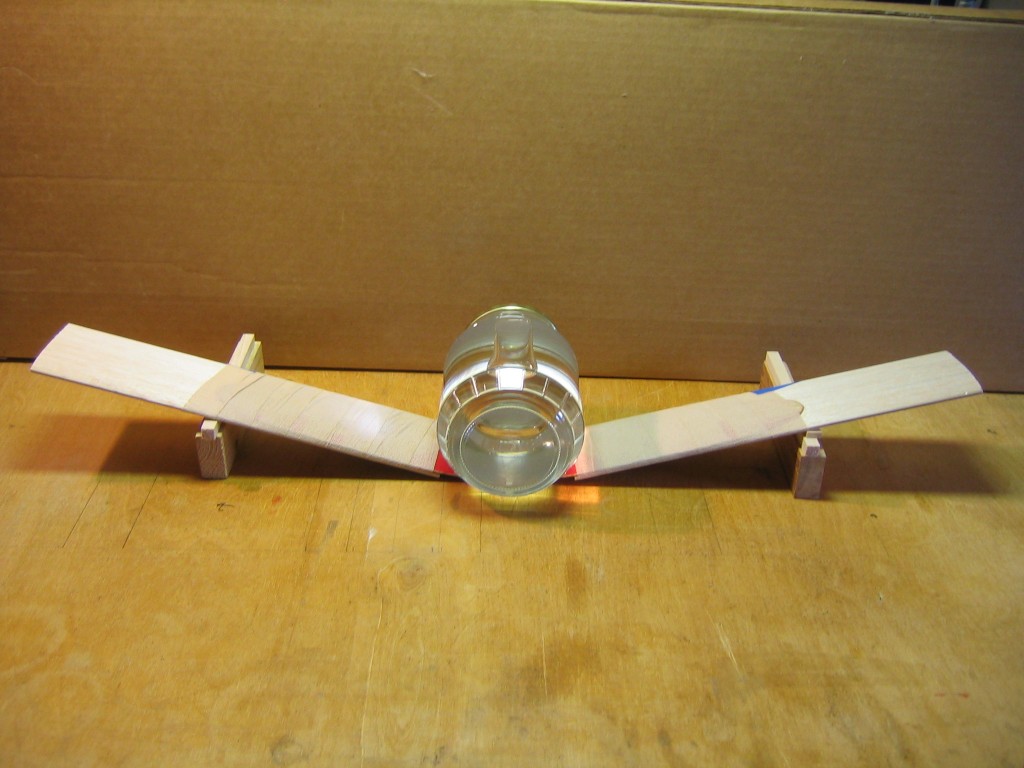The Jimmy Walker story may be found HERE.
I acquired an original AJ Hornet on eBay.
Note the distinguishing features; plastic prop with steel shaft and hook, plastic bearing/hanger and plastic wheels. I went to the American Junior Classics web page for help in dating this version. Hornets are not illustrated, but there is a dated series on the similar Pursuit.
This suggests this model may date from 1948-1962. Features of this particular kit are that the wing has no camber, no tail retaining rubber band or motor were present and the motor hook was missing. There were no holes or marks on the wood to suggest how the motor hook was formed or attached. There were no signs of wear on the prop or bearing, making me wonder whether it had ever been flown. There was a small chip out of the left wingtip trailing edge, easily repaired.
Pictures suggest the originals were flown with two dark rubber bands of about 1/8″ width, just a bit longer than the distance between the hooks.
I used this as a pattern to make copies as close to the original as possible. Based on documentary evidence that the wings were cambered, I wet formed dihedral and camber in the wings with a jig setup. I had no clear direction for the motor hook, so I fabricated a staple type, similar to those on the Guillow’s and Revell/Monogram planes, but with a proper hook in the end.
The Hornet is being replicated in modern form. I ordered two American Junior Classics Hornets, plus spare surfaces, here: http://www.americanjuniorclassics.com/ajstore/hornet.htm
This is distinguished by strong camber in the wings panels, a stick with different taper and the fin slot does not go all the way through the stick. A 9″ loop of 1/4″ is provided for the motor. I quickly found out that the cross section was way too much. Torque with only a few turns rolled it left into the ground and the usual fixes did not work. From the number of turns that would permit a level flight, I estimated that it would fly on an 18″ loop of 1/8″. With that I have gotten flights of a minute and a half in the small park where I fly. That motor also gives similar flights with my replicas.
I was still trying to find out about the motor hook, so I bid on another Hornet on eBay. This one was offered by some one in Palo Alto. I wondered whether it might be someone I knew. I won the bid and the owner turned out to be Bill Vanderbeek! Bill had it in his shop and had business in Campbell, near where I live, so he brought it over. We had a nice chat.
This one had all the parts except the tail retaining rubber band. As usual, I measured and weighed everything. This one has a plastic prop, but the prop has a hollow hub with a slot across the front. The rubber motor goes through the hub and around a steel wire pin that is pulled back into the slot. The hub extends into a metal bearing with a 1/4″ opening. This is according to Walker’s patent. I put a few turns into the motor and it didn’t unwind. There was a lot of friction. I took it apart to clean it and found that the black ring behind the prop was brass. After cleaning, a few turns in the motor would unwind. A drop of oil would likely help. The motor was cruddy so I washed it, too. It is a dark translucent black coffee brown. It was still soft and supple, except where it went around the prop pin. The wheels are balsa. This may date to before 1948. I have copied the motor hook and will put it on one of my extra sticks, to accurately reflect the original configuration. I also made a proper hook for my other original Hornet. This wing had washin on the right wing and washout on the left wing. That would not help the left roll dive. I decided to soak the wing and try for a bit of washin on the left wingtip. This shows my jig setup.
Each wing panel is strapped to a 12″ length of Sig 3″ airfoil board with a strip of Ace bandage. The center is held down with a 4 7/8″ diameter pickle jar full of water. (Early replica experiments with a 2″ dope jar broke the wood.) The tips are supported on blocks 1 3/4″ off the table. The left tip has a 1/8″ shim under the leading edge.
I want to get videos of both originals in flight. I need to be very careful where and when I fly them, because I don’t want them lost or damaged.
I plan a detailed article for EndlessLift.
Gary Hinze
Video of Frank Macy’s American Junior Classics factory:
Plan posted here: http://www.rcgroups.com/forums/showthread.php?t=933500





When I was a kid in the early 50s, on Sat. Mornings, my dad would take me to the local hobby shop to buy an A J Hornet. It was the absolute greatest treat. A fresh out of the box was the supreme moment of the week. I would fly it all weekend, where it would gradually degrade from accidents, overwinding the rubber, and getting caught in trees. A slight depression would set in , as my A J became unusable and Sunday night homework came due. The 10 cent “Go Hi” gliders were a cheaper substitute for the AJ, but were not on the same level of enjoyment. I still occasionally have DeJavu moments recalling the original boyhood excitement of a new AJ Hornet.
This is a nice page. Frank Macy was going to work on the Hornet history. He never got around to writing it but I remember a few things and may be able to find dates for the different versions. This may be a nice update for the American Junior Classics website.